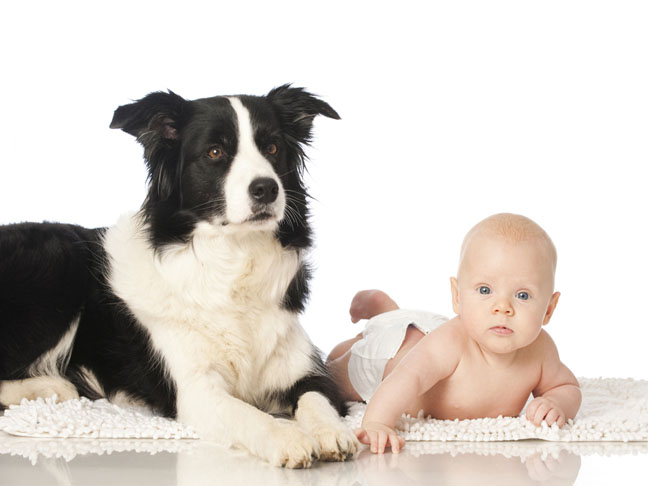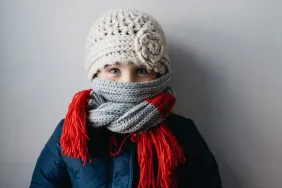If you’re expecting the arrival of your first baby and your dog has been playing the role of your “adored child” up until now, it’s important to do some careful planning to prepare everyone for this new transition.
While it might be a little bit embarrassing to openly admit, it’s often not all that unusual for couples who haven’t previously have children, to elevate their pets to a status that would almost mimic that of being their child. And I’m not being critical of this situation, nor do I believe that all couples should have children, but I’ll assume if you’re reading Momtastic, it’s likely you either already have kids or are considering having them sometime in the future.
So if you recognize a little bit of yourself in the above description and you have given your pooch the crown of being the adored “only child”, it’s only fair to do some planning ahead of time, so you and your pooch will be ready for you to bring home the new bundle. Here’s a checklist of a few simple ideas to help everyone in your family prepare for the arrival of your new family member.
Assess Your Dog’s Temperament
Here’s where you’ll need to take a step back and try to view and evaluate your dog as an unbiased outsider would. Observe and ask yourself questions like, is your dog aggressive and territorial if you get near his food bowl or toys? How does he act when approached by strangers? Is he overly sensitive about being petted or handled? Does he act uncomfortable or will he respond aggressively if you pull on his tail and ears, as an unknowing child might? If you don’t feel comfortable making these evaluations yourself, you can always ask for help from your veterinarian or consult with a professional dog trainer to help you with methods for how to deal with any problem issues.
Make Sure Your Dog Has Basic Training in Place
If in the past, you’ve been a little bit lenient in the training department, now’s a good opportunity to catch things up. And don’t be discouraged if your dog is older and not a puppy. Even older dogs can benefit from some professional training later in life. Putting a few solid basic training commands in place, like “sit”, “stay”, “leave it” and “down” will yield you volumes in the social quality of the life you have with your pet, and especially when a new baby comes into your family. If you have a dog that jumps wildly on visitors when you open your front door, you can imagine what a safety hazard this kind of untrained behavior will be when you bring a new baby into your home. Practice walking your dog on a loose leash, so that you’ll feel confident you’ll be able to safely walk your dog and push a stroller together in the future. If your dog has a tendency to be a “puller”, adding a harness or head halter can be helpful devices that will make leash walking more enjoyable. And if you have a young puppy, it’s even more important to make sure your puppy gets some proper training instilled early in life. So again, if you feel ill-equipped to handle implementing some basic training for your dog, don’t be embarrassed to seek the help of someone who has more experience or training. In fact, learning to feel comfortable about reaching out to seek help from those who are more knowledgeable and experienced, will be a good exercise to help begin to prepare you for learning how to become a good parent too.
Baby-Proofing and Preparing your Dog for Independence
If your dog is already crate trained, then you’re miles ahead with your preparation. If your dog is a puppy and isn’t crate trained, consider crate training him immediately by consulting a professional or breeder to learn more about how to do it. Dogs are cave animals by nature, so if you understand the basis of crate training, it is not cruel and can actually be somewhat instinctive and calming for your dog. Your dog will learn to appreciate having some of his own “down time” in his crate during times when you have a party or lots of guests in your home and also after you bring home your new baby too. The rest of basic baby-proofing that you will need to do, like adding child gates where necessary and making sure that your dogs food and sleep areas are distinctly separate and apart from those of your new baby. You can find lots of great information about baby-proofing online and by taking some basic parenting classes before your baby arrives.
If your dog has been the entire center of your attention up until now, don’t feel guilty about preparing your dog to learn to feel good about being independent and keeping himself entertained. It’s your responsibility to make sure that he still gets plenty of exercise and has an adequate supply of chew toys and other toys that will keep his mind fully engaged, without always needing you to dote on him excessively. This is really not all that different than how you will eventually prepare your child for their own independence, which is the ultimate goal of successful parenting.
Introducing Your Dog to Your New Baby
There are many things you can do to prepare your dog for the arrival of your new child into your home. One of the best things you can do to prepare your dog for the upcoming change in your family, is to foster his independence as we already discussed above. You can also go so far as to play recordings of baby noises, crying and associate those noises along with an occasional dog treat. In this way, your dog will begin to associate this new family member as being a positive new experience. After you have delivered your baby and while you and the baby are still in the hospital, you can have a family member bring home a blanket or piece of clothing that your newborn has worn and present it for your dog to smell. Once your dog has had a chance to smell it, then reward them with a dog treat immediately afterwards, so your dog will begin to associate this new family member as being a positive experience. This article of your baby’s clothing can then be reintroduced again in the same manner at several different times, until eventually you might even place it in your dog’s bed at night, so he begins to feel completely comfortable with the smell of your new family member.
On the day you finally bring your newborn home, if possible, it can be helpful if your first introduction to your dog is done on neutral territory, like outside in your yard or done on your porch, before you bring your new baby inside the house. While this first introduction is taking place, be sure to implement the basic training commands that are now firmly in place with your dog, like “sit” and “down”. Allow your dog a well supervised and brief sniffing introduction to your newborn, before all of you enter your home together. If you have already introduced your dog to a piece of your baby’s clothing as I previously suggested, the smell of your new family member should already be a familiar and positive experience for your dog.
As always, all of these are just some simple ideas and suggestions for things you can do to help prepare your dog for a new baby in your home and some of them are things I have had some experience doing myself. They should not be considered as a substitute for professional advice, so always be sure to consult your veterinarian or a professionally experienced dog trainer if you need help to evaluate and prepare your dog for the arrival of your new baby.








